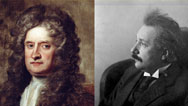Einstein: A Timeline of His Life
- Teacher Resource
- Posted 01.29.04
- NOVA
Albert Einstein, one of the world's most influential physicists, made more important scientific contributions in a single year than most scientists conceive of in a lifetime. This illustrated timeline outlines some of the most important events of his life.


- Media Type: Document
- Size: 140.6 KB
- Level: Grades 6-12
-
Log in to Teachers' Domain to download, share, rate, save, and match to state standards.
Source: NOVA: "Einstein Revealed"
Background
The eclipse, documented by British astronomer Sir Arthur Eddington off the west coast of Africa, was important because it helped prove Einstein's General Theory of Relativity.
One of Einstein's greatest, yet most abstract theories, the General Theory of Relativity, states that the force of gravity should affect light in much the same way it affects matter. The theory predicts that light should curve when in the presence of a strong gravitational field, such as the one created by our sun.
While Einstein was convinced of the validity of his theory, and even predicted how it might be proved, many people, including other physicists, found no reason to suggest that it was true. Isaac Newton's conclusions that light always travels in a straight line had not been disproved in more than 200 years.
In March of 1919, however, Sir Arthur Eddington's observations and photographs changed all that. Einstein had predicted that, if it was possible to view stars whose light passes quite near the sun, they should appear to be in a different place than where they actually are. This is because the light they emit would be bent as it passed through the sun's gravitational field. To prove such an idea, however, would require seeing the stars in the presence of the sun, or during the day -- an impossibility, except during a solar eclipse.
Eddington's photographs, taken during the 1919 eclipse, showed stars nearest the sun in positions different from those they occupied at night, in the sun's absence. The pictures were proof that light could, in fact, be affected by gravity, providing an important step toward the general acceptance of Einstein's General Theory of Relativity.
Questions for Discussion
- What major events occurred during Einstein's lifetime?
- What effect, if any, did these events have on his life and work?
- What were some of the great theories developed by Einstein? How have they changed our understanding of the cosmos?
Related Resources
-

Einstein: Genius Among Geniuses
To rank with Einstein or that other colossal genius Newton, you have to reinvent the way we see the world.
-

Einstein Revealed
A two-hour special revealing the hidden life of Albert Einstein and tracing the birth of his groundbreaking ideas
-

Einstein on Newton
In 1927, 200 years after Newton's death, Albert Einstein wrote a glowing appreciation.
-

Einstein's Big Idea
Consider E = mc2 by examining how much of different kinds of fuel would be required to make an imaginary trip to Pluto.





